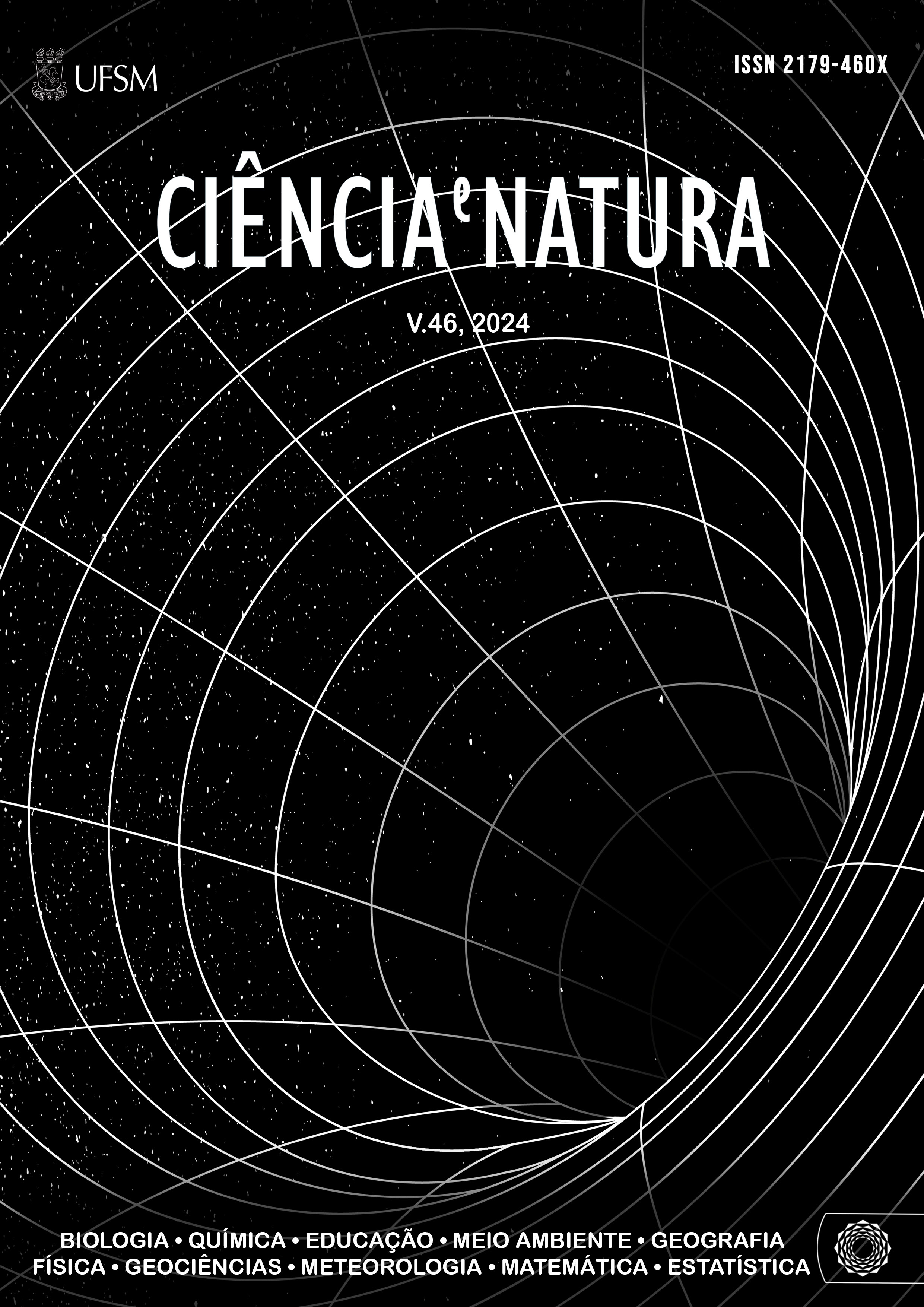Bifurcações de campos vetoriais descontínuos de codimensão um - os casos sela e nó no bordo
DOI:
https://doi.org/10.5902/2179460X83931Palavras-chave:
Bifurcações, Regularização, Campos vetoriais descontínuosResumo
Utilizamos o m´etodo de regularização de campos vetoriais descont´ınuos, descrito por (Sotomayor and Teixeira, 1998), para explicar, em termos das bifurcações cl´assicas, duas bifurcações de codimens˜ao, um de famílias de campos vetoriais descont´ınuos gerados pela colis˜ao de uma sela com o conjunto de descontinuidade, e outra a colis˜ao de um n´o com o mesmo conjunto. Essas bifurcações est˜ao contidas em uma lista apresentada igualmente por (Filippov, 1998), e por (Kuznetsov et al., 2003).
Downloads
Referências
Andronov, A. A., Vitt, A. A., & Khaikin, S. E. (1966). Theory of Oscillators. Pergamon Press, Oxford, 1nst edition. DOI: https://doi.org/10.1016/B978-1-4831-6724-4.50007-1
Buzzi, C. A. & Santos, R. A. T. (2019). Regularization of saddle-fold singularity for nonsmooth differential systems. Journal of Mathematical Analysis and Applications, 474(2):1036–1048. DOI: https://doi.org/10.1016/j.jmaa.2019.02.003
Colombo, A., di Bernardo, M., Hogan, S., & Jeffrey, M. (2012). Bifurcations of piecewise smooth flows: Perspectives, methodologies and open problems. Physica D: Nonlinear Phenomena, 241(22):1845–1860. Dynamics and Bifurcations of Nonsmooth Systems. DOI: https://doi.org/10.1016/j.physd.2011.09.017
Di Bernardo, M., Champneys, A., Budd, C., & Kowalczy, P. (2008). Piecewise-smooth Dynamical Systems. Springer-Verlag, London, 1nst edition. DOI: https://doi.org/10.4249/scholarpedia.4041
Filippov, A. F. (1998). Differential Equations with Discontinuous Righthand Sides: Control Systems (Mathematics and its Applications). Kluwer Academic Press, 1nst edition.
Guckenheimer, J. & Holmes, P. (1983). Nonlinear Oscillations, Dynamical Systems, and Bifurcation of Vector Fields. Springer-Verlag, New York, 1nst edition. DOI: https://doi.org/10.1007/978-1-4612-1140-2_1
Jeffrey, M. (2018). Hidden Dynamics: The Mathematics of Switches, Decisions and Other Discontinuous Behaviour. Springer Nature, 1nst edition. DOI: https://doi.org/10.1007/978-3-030-02107-8_1
Jeffrey, M. (2020). Modeling with Nonsmooth Dynamics. Springer Nature Switzerland, 1nst edition. DOI: https://doi.org/10.1007/978-3-030-35987-4
Kuznetsov, Y., Gragnani, S., & Rinaldi, A. (2003). One-parameter bifurcations in planar filippov systems. International Journal of Bifurcation and Chaos in Applied Sciences and Engineering, 13. DOI: https://doi.org/10.1142/S0218127403007874
Sotomayor, J. (1973). Generic Bifurcations of Dynamical Systems AMS (MOS) 1970 SUBJECT CLASSIFICATION: 58F99. In PEIXOTO, M., editor, Dynamical Systems, pages 561–582. Academic Press. DOI: https://doi.org/10.1016/B978-0-12-550350-1.50047-3
Sotomayor, J. & Machado, A. (2002). Structurally stable discontinuous vector fields in the plane. Qualitative Theory of Dynamical Systems, 3:227–250. DOI: https://doi.org/10.1007/BF02969339
Sotomayor, J. & Teixeira, M. (1998). Regularization of discontinuous vector fields. In Equadiff 95 : International Conference on Differential Equations. World Scientific.
Downloads
Publicado
Como Citar
Edição
Seção
Licença
Copyright (c) 2024 Ciência e Natura

Este trabalho está licenciado sob uma licença Creative Commons Attribution-NonCommercial-ShareAlike 4.0 International License.
Para acessar a DECLARAÇÃO DE ORIGINALIDADE E EXCLUSIVIDADE E CESSÃO DE DIREITOS AUTORAIS clique aqui.
Diretrizes Éticas para Publicação de Revistas
A revista Ciência e Natura está empenhada em garantir a ética na publicação e na qualidade dos artigos.
A conformidade com padrões de comportamento ético é, portanto, esperada de todas as partes envolvidas: Autores, Editores e Revisores.
Em particular,
Autores: Os Autores devem apresentar uma discussão objetiva sobre a importância do trabalho de pesquisa, bem como detalhes e referências suficientes para permitir que outros reproduzam as experiências. Declarações fraudulentas ou intencionalmente incorretas constituem comportamento antiético e são inaceitáveis. Artigos de Revisão também devem ser objetivos, abrangentes e relatos precisos do estado da arte. Os Autores devem assegurar que seu trabalho é uma obra totalmente original, e se o trabalho e / ou palavras de outros têm sido utilizadas, isso tem sido devidamente reconhecido. O plágio em todas as suas formas constitui um comportamento publicitário não ético e é inaceitável. Submeter o mesmo manuscrito a mais de um jornal simultaneamente constitui um comportamento publicitário não ético e é inaceitável. Os Autores não devem submeter artigos que descrevam essencialmente a mesma pesquisa a mais de uma revista. O Autor correspondente deve garantir que haja um consenso total de todos os Co-autores na aprovação da versão final do artigo e sua submissão para publicação.
Editores: Os Editores devem avaliar manuscritos exclusivamente com base no seu mérito acadêmico. Um Editor não deve usar informações não publicadas na própria pesquisa do Editor sem o consentimento expresso por escrito do Autor. Os Editores devem tomar medidas de resposta razoável quando tiverem sido apresentadas queixas éticas relativas a um manuscrito submetido ou publicado.
Revisores: Todos os manuscritos recebidos para revisão devem ser tratados como documentos confidenciais. As informações ou ideias privilegiadas obtidas através da análise por pares devem ser mantidas confidenciais e não utilizadas para vantagens pessoais. As revisões devem ser conduzidas objetivamente e as observações devem ser formuladas claramente com argumentos de apoio, de modo que os Autores possam usá-los para melhorar o artigo. Qualquer Revisor selecionado que se sinta desqualificado para rever a pesquisa relatada em um manuscrito ou sabe que sua rápida revisão será impossível deve notificar o Editor e desculpar-se do processo de revisão. Os Revisores não devem considerar manuscritos nos quais tenham conflitos de interesse resultantes de relacionamentos ou conexões competitivas, colaborativas ou outras conexões com qualquer dos autores, empresas ou instituições conectadas aos documentos.






